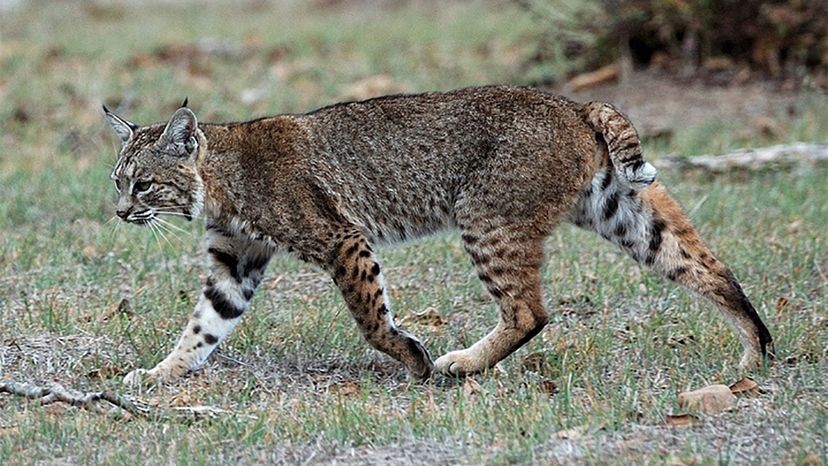How Big Is A Lynx Compared To A House Cat? At COMPARE.EDU.VN, we delve into the fascinating world of wild felines, comparing the size, characteristics, and habitats of lynx species to our familiar domestic companions, the house cat. Explore the remarkable physical attributes and unique adaptations of these elusive creatures. Discover the size differences, weights, and distinctive features, including behavior and diet.
1. Understanding the Lynx: An Overview
The lynx is a medium-sized wild cat belonging to the genus Lynx. Four distinct species comprise this genus: the Eurasian lynx (Lynx lynx), the Spanish or Iberian lynx (Lynx pardinus), the Canada lynx (Lynx canadensis), and the bobcat (Lynx rufus). While all share the iconic tufted ears and short tail, significant differences exist in size, appearance, and habitat. This detailed comparison provided by COMPARE.EDU.VN allows us to determine their key differences.
1.1. Lynx Species and Their Habitats
Understanding the range and environment each species inhabits helps in appreciating their adaptations.
- Eurasian Lynx: The largest and most widespread, found throughout Europe and Asia.
- Spanish Lynx: Critically endangered, native to the Iberian Peninsula (Spain and Portugal).
- Canada Lynx: Primarily resides in Canada and some northern U.S. states.
- Bobcat: Most common in North America, adaptable to various habitats.
2. Physical Comparison: Lynx vs. House Cat
Let’s compare the lynx to the domestic cat, focusing on size, weight, and notable physical characteristics.
2.1. Size and Weight
Lynx species are considerably larger than the average house cat.
| Feature | House Cat (Average) | Lynx (Average) |
|---|---|---|
| Length | 18 inches (46 cm) | 30-50 inches (76-127 cm) |
| Height | 9-10 inches (23-25 cm) | 24-28 inches (61-71 cm) |
| Weight | 8-10 pounds (3.6-4.5 kg) | 15-60 pounds (6.8-27 kg) |
| Body Length | 18 in (46 cm) | 30-50 in (76-127 cm) |
2.2. Distinctive Physical Traits
Lynx species have unique features that set them apart from house cats.
- Ear Tufts: Long, black tufts of fur on their ears, enhancing hearing.
- Facial Ruff: A prominent ruff of fur around their cheeks.
- Legs and Paws: Longer legs and larger paws, aiding in snow traversal.
- Tail: Short, “bobbed” tail, usually with a black tip.
3. Detailed Look at Lynx Species
While comparing the entire Lynx genus to house cats provides a general idea, let’s examine each species individually.
3.1. Eurasian Lynx (Lynx lynx)
The Eurasian lynx is the largest of the lynx species. This magnificent creature exhibits impressive features.
- Size: Body length of 31-51 inches (80-130 cm).
- Weight: Typically weighs between 40-66 pounds (18-30 kg), but some Siberian lynx subspecies can reach up to 84 pounds (38 kg).
- Appearance: Dense, spotted coat, long ear tufts, and a short tail with a black tip.
3.2. Spanish Lynx (Lynx pardinus)
The Spanish lynx, also known as the Iberian lynx, is one of the world’s most endangered cat species.
- Size: Smaller than the Eurasian lynx.
- Weight: Ranges from 20-33 pounds (9-15 kg).
- Appearance: Distinctive spotted coat, shorter legs, and a black-tipped tail.
3.3. Canada Lynx (Lynx canadensis)
The Canada lynx is well-adapted to the snowy, forested regions of North America.
- Size: Medium-sized lynx.
- Weight: Weighs between 11-37 pounds (5-17 kg).
- Appearance: Dense, grayish-brown coat, long ear tufts, large paws for snow travel, and a short, black-tipped tail.
3.4. Bobcat (Lynx rufus)
The bobcat is the most common wild cat in North America and is highly adaptable.
- Size: Similar in size to a large domestic cat but more muscular.
- Weight: Ranges from 15-40 pounds (6.8-18 kg).
- Appearance: Shorter ear tufts than other lynx species, a spotted coat, and a bobbed tail with black bands.
4. Behavior and Diet
Beyond physical attributes, understanding the behavior and diet of lynx species further differentiates them from house cats.
4.1. Hunting and Predatory Behavior
Lynx species are skilled hunters, each adapted to their environment and prey.
- Eurasian Lynx: Hunts a variety of prey, including deer, rodents, and birds.
- Spanish Lynx: Primarily feeds on rabbits, making it highly vulnerable to rabbit population declines.
- Canada Lynx: Specializes in hunting snowshoe hares, which comprise a significant portion of its diet.
- Bobcat: Has a varied diet, preying on small mammals, birds, and occasionally larger animals like deer.
4.2. Social Behavior
Lynx species generally exhibit solitary behavior, except during mating season.
- Territorial: They establish and defend territories, using scent marking and vocalizations.
- Communication: Lynx communicate through various methods, including scent marking, vocalizations, and body language.
5. Habitat and Distribution
The habitat and distribution of lynx species vary significantly, influencing their physical and behavioral adaptations.
5.1. Habitat Preferences
Each lynx species prefers specific habitats:
- Eurasian Lynx: Inhabits forests, rocky terrains, and sometimes grasslands.
- Spanish Lynx: Found in Mediterranean scrubland and forests.
- Canada Lynx: Thrives in boreal forests with dense undergrowth.
- Bobcat: Adapts to diverse environments, including forests, swamps, deserts, and urban areas.
5.2. Geographical Distribution
Understanding where each species lives provides insights into their unique challenges and adaptations.
- Eurasian Lynx: Found across Europe and Asia.
- Spanish Lynx: Confined to the Iberian Peninsula.
- Canada Lynx: Primarily located in Canada and parts of the northern United States.
- Bobcat: Distributed throughout North America, from southern Canada to Mexico.
6. Conservation Status and Threats
The conservation status of lynx species varies, with some facing significant threats.
6.1. Conservation Status
Assessing the conservation status of each species helps prioritize conservation efforts.
- Eurasian Lynx: Least Concern, but populations are fragmented and face habitat loss.
- Spanish Lynx: Critically Endangered, with populations recovering through intensive conservation programs.
- Canada Lynx: Listed as Threatened in the United States, with populations fluctuating based on snowshoe hare availability.
- Bobcat: Least Concern, with stable populations across its range.
6.2. Threats to Lynx Populations
Various factors threaten lynx populations, including habitat loss, hunting, and climate change.
- Habitat Loss: Deforestation and urbanization reduce available habitat.
- Hunting and Trapping: Legal and illegal hunting pose threats in some areas.
- Climate Change: Altered snow patterns and temperatures impact snowshoe hare populations, affecting Canada lynx survival.
- Human Encroachment: Human activities disrupt lynx habitats and prey availability.
7. Distinguishing Features: Lynx vs. House Cat
To summarize, let’s highlight the key differences between lynx species and house cats.
7.1. Physical Differences
| Feature | House Cat | Lynx |
|---|---|---|
| Size | Smaller | Larger |
| Weight | Lighter | Heavier |
| Ear Tufts | Absent or small | Long and prominent |
| Facial Ruff | Absent | Present |
| Tail | Long | Short, “bobbed” |
| Fur | Typically shorter | Denser and longer |
7.2. Behavioral Differences
| Behavior | House Cat | Lynx |
|---|---|---|
| Social Structure | Social or solitary | Solitary |
| Hunting Style | Opportunistic | Specialized |
| Activity Pattern | Diurnal and nocturnal | Primarily nocturnal |
8. Frequently Asked Questions (FAQ)
Here are some common questions about lynx species and their comparison to house cats.
8.1. What is the average lifespan of a lynx?
The average lifespan of a lynx in the wild is about 10-17 years, while domestic cats can live up to 20 years with proper care.
8.2. Are lynx dangerous to humans?
Lynx are generally shy and avoid humans. Attacks are rare, but it’s essential to maintain a safe distance if encountered.
8.3. Can a lynx be kept as a pet?
It is illegal and unethical to keep a lynx as a pet in most areas. They are wild animals with specific needs that cannot be met in a domestic setting.
8.4. What do lynx eat?
Lynx diets vary by species. The Canada lynx primarily eats snowshoe hares, while other species consume rodents, birds, and larger mammals.
8.5. How do lynx adapt to snowy environments?
Lynx have large paws that act like snowshoes, preventing them from sinking into deep snow. Their dense fur provides insulation against cold temperatures.
8.6. Where can I see a lynx in the wild?
Lynx sightings are rare due to their elusive nature. Canada and the northern United States are good places to spot Canada lynx. National parks and protected areas offer the best chances for observation.
8.7. What role do lynx play in their ecosystems?
Lynx are apex predators, helping to regulate populations of their prey. Their presence indicates a healthy ecosystem.
8.8. How can I support lynx conservation?
Support organizations dedicated to wildlife conservation, advocate for habitat protection, and educate others about the importance of preserving these magnificent animals.
8.9. What are the main threats to lynx populations?
The primary threats include habitat loss, hunting, and climate change, which affects their prey populations.
8.10. How do scientists study lynx populations?
Scientists use various methods, including camera trapping, radio collaring, and DNA analysis, to study lynx populations and their behavior.
9. The Role of COMPARE.EDU.VN
At COMPARE.EDU.VN, we provide comprehensive comparisons and information to help you understand the nuances between different species, products, and services. Our detailed analyses enable you to make informed decisions and appreciate the world around you. For example, understanding ‘how big is a lynx compared to a house cat’ provides insights into their ecological roles and conservation needs.
10. Conclusion
The lynx, a fascinating wild cat, is significantly larger and has distinct physical and behavioral traits compared to the average house cat. Understanding these differences allows us to appreciate the unique adaptations of each species and the importance of conservation efforts to protect these remarkable animals. For more detailed comparisons and information, visit COMPARE.EDU.VN.
Are you struggling to make informed decisions? Do you find it challenging to compare different options objectively? At COMPARE.EDU.VN, we provide comprehensive and unbiased comparisons to help you make the best choices. Whether you’re comparing animal species, products, or services, our detailed analyses offer clear insights and support your decision-making process.
Visit COMPARE.EDU.VN today and discover how easy it is to compare and choose wisely. Contact us at 333 Comparison Plaza, Choice City, CA 90210, United States. Reach out via WhatsApp at +1 (626) 555-9090 or visit our website at COMPARE.EDU.VN for more information.
Alt Text: Canada lynx perched on a snowy branch, showcasing its thick fur and large paws, essential adaptations for survival in cold, snowy environments
Alt Text: Eurasian lynx portrait, highlighting its spotted coat, pointed ears with tufts, and intense gaze, characteristic of this widespread wild cat species
Alt Text: Bobcat in a natural setting, demonstrating its adaptable coat color and pattern that allows for effective camouflage in various environments
Alt Text: Iberian lynx, showcasing its distinctive spotted fur and slender build, adaptations essential for hunting rabbits in the Iberian Peninsula’s scrubland habitats
Alt Text: Side-by-side comparison of a house cat and a lynx highlighting differences in body length, height, and overall size to emphasize the lynx’s larger proportions
Alt Text: Close-up of a lynx paw showing its large size and fur-covered pads, crucial for distributing weight and providing traction on snow to facilitate hunting in winter
Alt Text: Boreal forest, the primary habitat of the Canada lynx, depicting dense trees and undergrowth, which provide shelter and hunting grounds for the species
Alt Text: Iberian lynx being released into the wild in Spain, showing conservation efforts aimed at increasing the population of this critically endangered species
Alt Text: Lynx tracks in the snow showing distinctive paw prints that help track and monitor lynx populations in snowy environments, aiding conservation research
Alt Text: Camera trap image of a lynx, illustrating a non-invasive method used by scientists to monitor and study elusive lynx populations in their natural habitats
Alt Text: Comparative size infographic of various carnivores including the Lynx, providing a visual reference to understand relative body sizes within their ecological context
{width=828 height=466}Alt Text: Bobcat along Calero Creek Trail in San Jose, highlighting its adaptability to human-impacted environments

